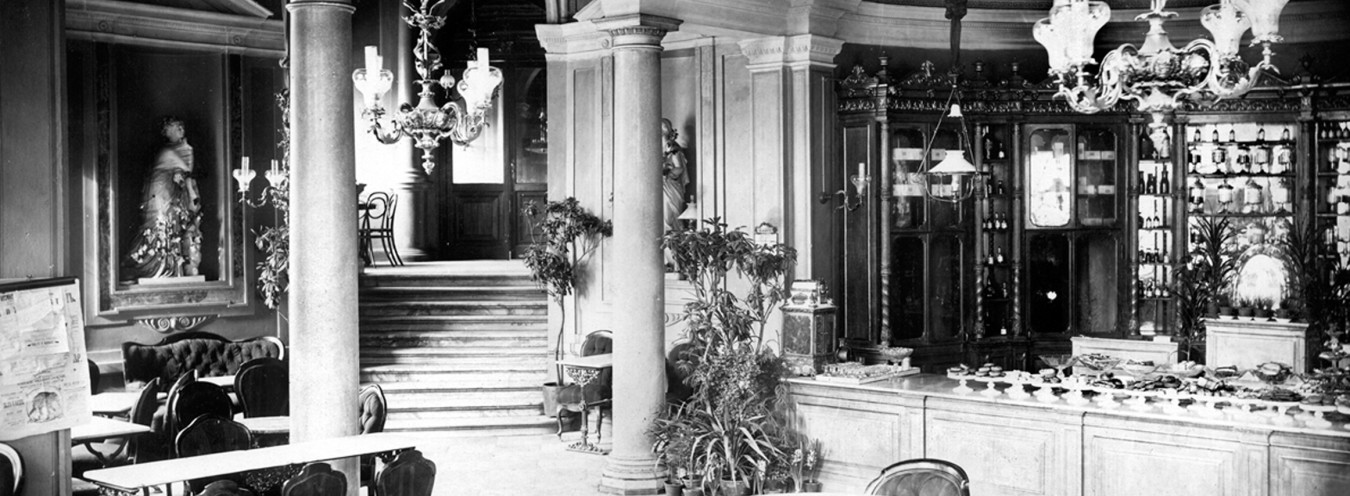
Restaurants and Cafés
[Figure courtesy of the Warsaw Public Library – Central Library of the Masovian Province]
One day, [Izabela] and Flora had gone into a cafe for chocolate, just for a lark. They sat by the window, behind which several ragged children gathered. The children looked in at her, at the chocolate and the cakes with the curiosity and greed of starving animals. (53)
The characters in The Doll frequent many restaurants and cafés. The novel mentions some real-life places in Warsaw, e.g. the Lesisz wine cellars and the best-known Fukier’s cellars in the Main Square of the Old Town (where wine could be tasted and a meal taken in the so-called “Breakfast Room”). There are also references to fine restaurants, often situated in luxurious hotels (e.g. the Europejski Hotel, where Wokulski holds a dinner to celebrate the opening of his new store). In fact, the whole novel starts with a scene set in an unspecified celebrated restaurant, where rich tradesmen wash down Beef Nelson with beer and exchange gossip on Wokulski and his company. Shop assistants and owners can also have lunch brought to their workplaces or homes.
It is typical that eating places are full of men who go there to eat, drink, read newspapers, talk to one another and do business, but they have no women customers. After his visit to the theatre, Ignacy Rzecki entered a restaurant where a band consisting of fiddles, a pianoforte and a harp was playing. He ate roast meat with potatoes and cabbage before seven mugfuls of beer made him cast disapproving glances towards Germans, sitting at another table over tripe and onions. The beer also makes him emotional, and his eyes tear up at the sound of the Marseillaise. The next day, the old clerk is embarrassed at the recollection of his little night out, brought about by the sight of Retzler’s building with its Bavarian-style bar in Krakowskie Przedmieście (the increasing number of such places, modelled on German establishments, offered primarily Bavarian beer and bowling as entertainment; they were quickly winning over the Warsaw bourgeoisie and pushing traditional bars out of the city centre). Before the auction of the Łęckis’ tenement house, Rzecki drops into a café on the corner of Kapitulna and Miodowa Streets (it was an actual place established in 1791 by Wawrzyniec Lourse, the “father of Warsaw cafés,” located opposite the Capuchin Church). There, over a cup of foaming chocolate, hid behind a torn newspaper, Rzecki happens to overhear a conversation of old Szlangbaum and an indebted individual, who have tea and cakes while they discuss the latter’s pay for bidding up the price of the auctioned house. Under the canopy of the same café Doctor Szuman is having ice-cream when he notices Wokulski and rushes to congratulate him on his improvement: What a look! What an eye!
In Prus’s Warsaw, cafés not only served hot beverages and cakes but also offered entertainment such as billiard games, chess matches of top Warsaw players, and gossip. In respect to this last function, the Warsaw hub in the 1870s and 1880s was the Lourse establishment in the Europejski Hotel (by then run by Bernard Semadeni), which was frequented by journalists and editors of the Kurier Warszawski newspaper, including the author of The Doll. Potential patrons were also attracted by remarkable events and ambitious projects, and so the first attempts at telephone communication in the Polish territories took place between the Saska café and the Pika optical shop in Niecała Street on 12 January 1878. By contrast, no particular attention was given to the interior design: café interiors were usually dark and cramped, often filled with smoke. Furnishings were mostly limited to buffet counters with protective glass over items of confectionery, unupholstered chairs and marble-top tables. It was not until the very end of the century that cafés were equipped with padded armchairs, courtains, mirrors, flower arrangements, and napkins in holders. Small wonder, then, that at the time of The Doll women did not go into cafés (or any other public places of this sort, not to damage their reputation). This is why Izabela and her chaperone’s visit to a café, just for a lark, seems like a whimsy of a bored damsel.
On the other hand, Prus does not mention Warsaw’s bistro-type bars, so numerous in the second half of the nineteenth century, at all. Compared to cafés, they had an even more modest decor, did not produce or sell confectionery “to go,” and tried to attract patrons by serving alcohol and a wider choice of food and meals. They also offered non-culinary attractions such as artistic performances, open-air theatre, and magic trick shows. Such establishments were very common in Paris, and so they are visited by Wokulski when he stays there: drinking coffee and brandy, he observes the life of the metropolis through the window and thinking about the unreachable Izabela Łęcka.
The actual surnames of Retzler, Lesisz, and Fukier, the descriptions of crowded cafés and names of meals served at restaurants make for a realistic portrait of the nineteenth-century middle-class Warsaw, the city of authentic and factual stores, restaurants, cafés, wine cellars and flower shops of that time, as Józef Bachórz puts it.
→ Alcohol; → Europejski Hotel; → Cuisine;
Bibliografia
- F. M. Sobieszczański, W. Szymanowski, Przewodnik po Warszawie, prefaced by F. Fryze and I. Chodorowicz, Warsaw 1873.
- W. Herbaczyński, W dawnych cukierniach i kawiarniach warszawskich, Warsaw 1983.
- J. Bachórz, Introduction to B. Prus, Lalka, BN I 262, Wrocław 1991, 1998.


